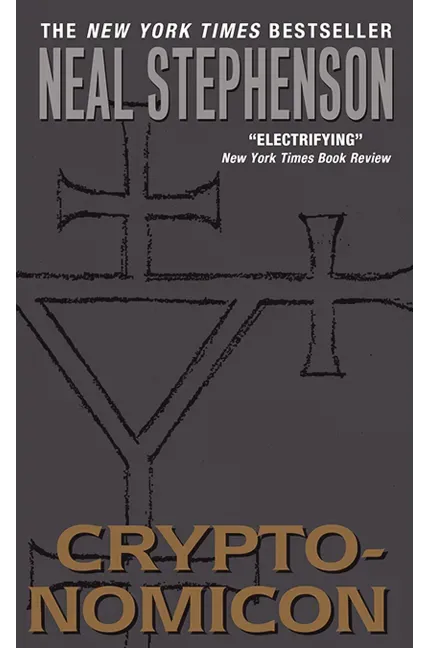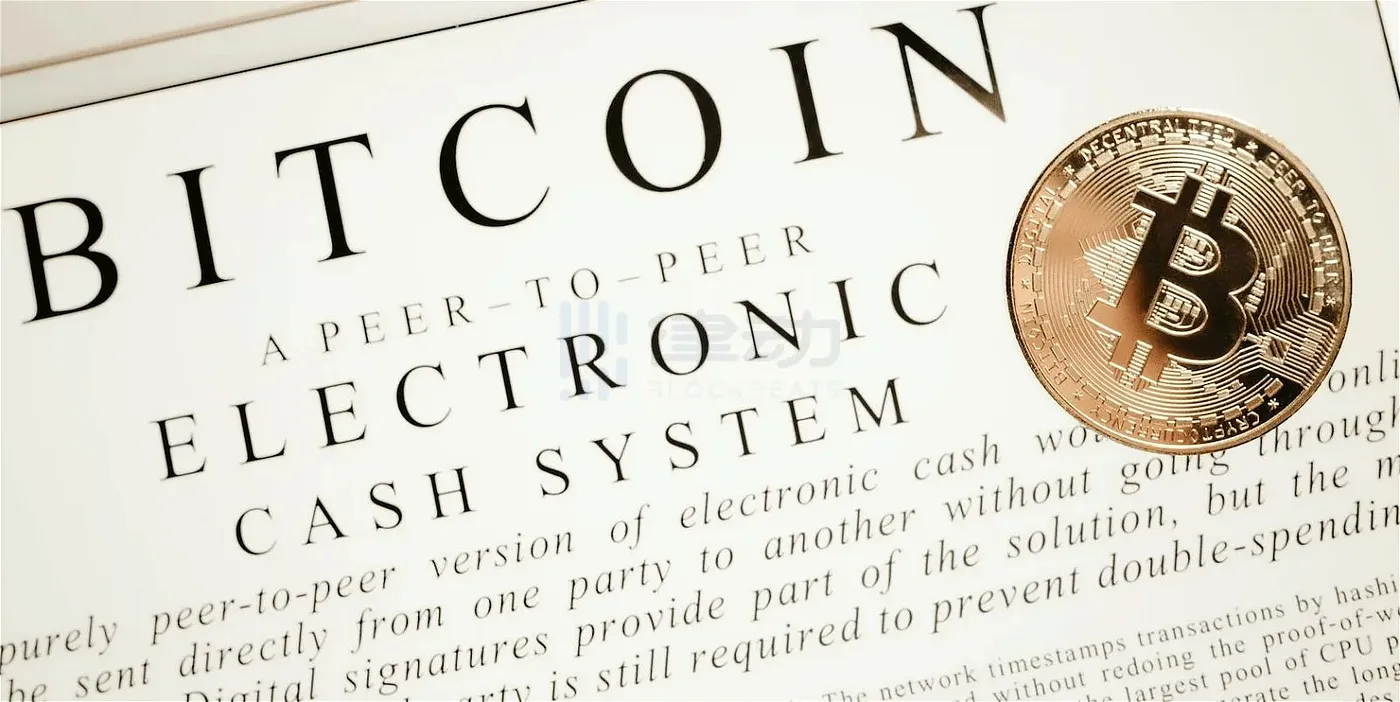Preface
In 1999, when the Internet was not yet popular and digital technology was still in its infancy, Neal Stephenson foresaw the potential of cryptocurrency and decentralized systems in his novel "Cryptonomicon". This foresight is not only reflected in this classic work, but also runs through many of his other works, such as the concept of "metaverse" in "Snow Crash". Many of the ideas in the book have become reality today, so a question arises: Did Neal Stephenson's work provide inspiration for Satoshi Nakamoto and his Bitcoin?
In this article, we will explore how Neal foresaw the future of cryptocurrency through "Cryptonomicon", analyze the similarities and differences between the technological concepts in the novel and Bitcoin, discuss Neal's unique insights, and introduce his latest exploration in Lamina1. Let's see how he foresaw and shaped the future of cryptocurrency in literary creation.
1. Neal Stephenson and "Cryptonomicon"

Neal is a renowned contemporary science fiction writer. His classic work "Cryptonomicon" published in 1999 not only caused a sensation in the literary world, but also sparked profound thoughts in the technology and finance sectors. "Cryptonomicon" is an epic novel that spans time and space, combining elements of history, technology, and adventure. The story spans the World War II era and the present, telling the adventurous journey of cryptographers, hackers, and mathematicians through two timelines.
In the World War II timeline, the novel tells the story of Allied cryptographer Lawrence Waterhouse and Marine Bobby Shaftoe, who collaborated with the Allies to crack the Nazi German encryption system. In the modern timeline, Lawrence's grandson Randy Waterhouse is a computer scientist who, along with his friends, is dedicated to creating a cryptography-based digital currency system, aiming to promote the use of electronic currency and (later) digital gold currency in anonymous online banking. The book also features many historical figures, such as Alan Turing, Albert Einstein, Douglas MacArthur, Winston Churchill, Isoroku Yamamoto, Karl Dönitz, Hermann Göring, and Ronald Reagan. The book is also known for its high technicality, detailing modern cryptographic principles based on information theory, modular arithmetic, and prime factorization (such as RSA), as well as other topics in the field of computer security, including the UNIX operating system.
Neal is known for his detailed technical descriptions and complex story structures, and "Cryptonomicon" is no exception. The novel's rich historical and technical details have attracted many readers, while also revealing the importance of encryption technology in safeguarding information security and personal privacy. "Cryptonomicon" is not only a thrilling adventure story, but also a prophecy of modern digital currency and decentralized systems. With the rise of Bitcoin and cryptocurrency, many of the ideas proposed by Neal at the end of the 20th century have gradually become reality. So, what specific content in this work foreshadowed today's cryptocurrency? How did it have a profound impact on the modern digital economy?
2.1 Early Depiction of Cryptocurrency Concepts

2.1 Concept of Electronic Currency
In "Cryptonomicon", Neal detailed a company called "Epiphyte Corporation" that is dedicated to developing a cryptography-based digital currency system. This company aims to create a secure, anonymous, and decentralized electronic payment system using advanced encryption technology and distributed networks. The electronic currency in the novel is designed to be a globally universal electronic payment method that bypasses traditional banking systems to enable direct peer-to-peer transactions.
This concept bears significant similarities to today's cryptocurrency systems. Although Bitcoin did not emerge until 2008, Neal had already depicted a similar concept in 1999, which is undoubtedly forward-looking.
2.2 Public Key Encryption and Digital Signatures
In "Cryptonomicon", Neal describes the use of public key encryption and digital signatures for virtual currency transactions. Each user has a pair of public and private keys, and transactions of virtual currency are conducted using public key encryption technology. These technologies form the foundation of modern cryptocurrency systems.
Public key encryption is an asymmetric encryption technology, centered around the generation and use of key pairs. Each user generates a pair of keys: a public key, which is publicly available and can be freely shared, and a private key, which must be kept strictly confidential. This design ensures the security and privacy of information transmission. In the novel, Randy Waterhouse and his team members frequently exchange sensitive information, which is protected using public key encryption technology. When Randy needs to send encrypted information, he uses the recipient's public key for encryption. The public key encryption process transforms plaintext data into ciphertext, ensuring that even if the information is intercepted, only the recipient holding the corresponding private key can decrypt and read it. This method effectively protects the security of information during transmission. The recipient uses their private key to decrypt the received ciphertext back into plaintext. Only the person holding the correct private key can decrypt the information, ensuring both security and high privacy of encrypted communication. Through this method, Randy's team members can securely transmit confidential data, ensuring the security and confidentiality of information.

Digital signatures are another key technology used to verify the integrity and authenticity of data. It ensures that data has not been tampered with and is indeed created by a specific sender. In "Cryptonomicon", Randy and his team extensively use digital signature technology to protect the reliability of transactions and communications. When Randy needs to send a transaction or important information, he first calculates the hash value of the data to be signed. A hash algorithm transforms data of any length into a fixed-length hash value. This step ensures the consistency and integrity of the data. Subsequently, Randy uses his private key to encrypt the hash value, generating a digital signature. This process ensures that the signature can only be generated by Randy, preventing others from forging the signature. Upon receiving the signature and original data, the recipient uses Randy's public key to decrypt the digital signature, obtaining the hash value. Then, the recipient recalculates the hash value of the received original data. If the two hash values match, the verification is successful, proving that the data has not been tampered with and was indeed created by Randy. This way, digital signature technology not only ensures the integrity of data, but also confirms the identity of the sender.
These mechanisms are very similar to how Bitcoin transactions work. Bitcoin users have a key pair: a public key (i.e., Bitcoin address) for receiving Bitcoin, and a private key for signing transactions to prove that the transaction is initiated by the legitimate owner. This encryption and signature technology ensures the security and non-repudiation of Bitcoin transactions, allowing users to confidently engage in peer-to-peer transactions.
2.3 Decentralized Network
In the novel, Neal depicts a distributed system that does not require a central authority to maintain the integrity and security of data. This concept bears a striking resemblance to Bitcoin's blockchain technology.
In the Bitcoin system, the blockchain serves as a distributed ledger that records all transaction information. Each node stores a complete copy of the ledger, ensuring the transparency and immutability of the data. Through the Proof of Work mechanism, nodes collectively participate in transaction verification and recording, ensuring the decentralization and security of the entire system.
2.4 Privacy Protection and Anonymity
Privacy protection and anonymity are important themes in "Cryptonomicon". Neal describes how encryption technology protects user privacy, making transactions untraceable and unmonitored, a concept that is also reflected in modern cryptocurrencies.
While Bitcoin is not completely anonymous, it provides a certain level of privacy protection through the use of public key addresses and obfuscation techniques. The user's real identity is not directly linked to their Bitcoin address, providing a high degree of anonymity in transactions. Furthermore, some subsequent cryptocurrencies (such as Monero and Zcash) further enhance privacy protection and achieve a higher level of transaction anonymity through more complex encryption technologies.
2.5 Implementation of Digital Currency
Through the early concept of digital currency in "Cryptonomicon", a cryptography-based digital economic system is showcased. In the real world, Neal's predictions have gradually become reality, with digital currencies being widely used globally. Digital currencies have not only changed the way people make payments and transactions, but also driven the application of blockchain technology in various fields such as finance, supply chain, and healthcare. The future depicted in the novel is gradually becoming a reality, proving Neal's outstanding ability in technological foresight and insight.
The inventor of Bitcoin, Satoshi Nakamoto, may have been inspired by "Cryptonomicon" and drawn important technological concepts and design ideas from it. In the following sections, we will delve into the birth of Bitcoin and analyze the differences between the digital currency in "Cryptonomicon" and Bitcoin.
3. Satoshi Nakamoto and the Birth of Bitcoin

3.1 Background and Origin of Bitcoin
In 2008, a mysterious figure using the pseudonym Satoshi Nakamoto released the whitepaper "Bitcoin: A Peer-to-Peer Electronic Cash System", detailing a new decentralized digital currency—Bitcoin. This whitepaper proposed a trustless electronic payment system achieved through a peer-to-peer network and cryptographic technology. In 2009, the Bitcoin network was officially launched, and the first Bitcoin block—the Genesis Block—was mined by Satoshi Nakamoto, marking the official birth of Bitcoin.
The birth of Bitcoin has a complex and far-reaching socio-economic significance. The global financial crisis of 2008 led to widespread distrust of traditional financial systems, and the decentralized digital currency system was proposed in this context. The envisioned Bitcoin system by Satoshi Nakamoto aimed to address many issues in traditional financial systems, such as high transaction costs, delays, centralized control, and potential corruption risks.
3.2 Core Ideas of the Bitcoin Whitepaper
Satoshi Nakamoto's Bitcoin whitepaper proposed several core ideas that laid the foundation for the development of Bitcoin and subsequent cryptocurrencies:
- Decentralization: The Bitcoin network achieves decentralization through a distributed ledger (blockchain), with all nodes collectively maintaining the ledger, eliminating the reliance on central authority.
- Peer-to-Peer Transactions: Users can directly engage in transactions without intermediaries such as banks or payment processors, reducing transaction costs and complexity.
- Proof of Work (PoW): Bitcoin utilizes the Proof of Work mechanism to ensure the security and immutability of the blockchain through complex mathematical computations.
- Limited Supply: The total supply of Bitcoin is set at 21 million, ensuring its scarcity and avoiding inflation.
The introduction and implementation of these ideas made Bitcoin the first successful decentralized digital currency and had a profound impact on the global financial system in the following decade.
3.3 Influence of "Cryptonomicon" on Bitcoin

Although "Cryptonomicon" foresaw many concepts of cryptocurrency, as a work of fiction, it did not actually apply to economic transactions or monetary systems. Therefore, its discussion and depiction are more theoretical concepts or technological ideas in science fiction stories. However, it may have had a significant impact on the design of Bitcoin by Satoshi Nakamoto. Neal detailed a digital currency system based on cryptography and distributed systems in the novel, a concept that aligns with many core principles of Bitcoin.
3.3.1 Application of Cryptography
In "Cryptonomicon", Neal provides an in-depth portrayal of the application of cryptography, demonstrating how public key encryption and digital signatures ensure the security and anonymity of electronic currency transactions. When designing Bitcoin, Satoshi Nakamoto extensively drew on these cryptographic technologies, implementing Bitcoin's security and transaction verification through the use of the SHA-256 hash algorithm and ECDSA (Elliptic Curve Digital Signature Algorithm).
3.3.2 Concept of Decentralization
Stephenson proposed a distributed system in the novel that does not rely on central authority, a concept that is fully reflected in the design of Bitcoin. Satoshi Nakamoto achieved decentralization through blockchain technology, distributing transaction records across countless nodes globally, with each node maintaining a complete copy of the ledger. This decentralized design not only enhances the security and reliability of the system but also avoids the risks of single points of failure and centralized control.
3.3.3 Anonymity and Privacy Protection
"Cryptonomicon" emphasizes the importance of privacy protection and anonymity, depicting a digital currency system that protects user privacy through encryption technology. Bitcoin provides a certain level of anonymity through the use of public key addresses and obfuscation techniques, ensuring that the user's real identity is not directly linked to their Bitcoin address. This design inherits the privacy protection concept depicted in "Cryptonomicon" to a certain extent.
3.4 Differences Between "Cryptonomicon" and Bitcoin

While "Cryptonomicon" foresaw many concepts of cryptocurrency, as a work of fiction, it did not actually apply to economic transactions or monetary systems. Therefore, its discussion and depiction are more theoretical concepts or technological ideas in science fiction stories. However, it may have had a significant impact on the design of Bitcoin by Satoshi Nakamoto. Neal detailed a digital currency system based on cryptography and distributed systems in the novel, a concept that aligns with many core principles of Bitcoin.
3.3.1 Application of Cryptography
In "Cryptonomicon", Neal provides an in-depth portrayal of the application of cryptography, demonstrating how public key encryption and digital signatures ensure the security and anonymity of electronic currency transactions. When designing Bitcoin, Satoshi Nakamoto extensively drew on these cryptographic technologies, implementing Bitcoin's security and transaction verification through the use of the SHA-256 hash algorithm and ECDSA (Elliptic Curve Digital Signature Algorithm).
3.3.2 Concept of Decentralization
Stephenson proposed a distributed system in the novel that does not rely on central authority, a concept that is fully reflected in the design of Bitcoin. Satoshi Nakamoto achieved decentralization through blockchain technology, distributing transaction records across countless nodes globally, with each node maintaining a complete copy of the ledger. This decentralized design not only enhances the security and reliability of the system but also avoids the risks of single points of failure and centralized control.
3.3.3 Anonymity and Privacy Protection
"Cryptonomicon" emphasizes the importance of privacy protection and anonymity, depicting a digital currency system that protects user privacy through encryption technology. Bitcoin provides a certain level of anonymity through the use of public key addresses and obfuscation techniques, ensuring that the user's real identity is not directly linked to their Bitcoin address. This design inherits the privacy protection concept depicted in "Cryptonomicon" to a certain extent.
3.4 Differences Between "Cryptonomicon" and Bitcoin
While "Cryptonomicon" foresaw many concepts of cryptocurrency, as a work of fiction, it did not actually apply to economic transactions or monetary systems. Therefore, its discussion and depiction are more theoretical concepts or technological ideas in science fiction stories. However, it may have had a significant impact on the design of Bitcoin by Satoshi Nakamoto. Neal detailed a digital currency system based on cryptography and distributed systems in the novel, a concept that aligns with many core principles of Bitcoin.
3.4.1 Complete Decentralization and Trust Mechanism
In "Cryptonomicon", Randy and his team designed an electronic currency system aimed at achieving anonymous transactions and privacy protection. This system relies on cryptography to ensure the security and anonymity of transactions. The public key encryption and digital signature technologies mentioned in the system ensure the legitimacy and non-repudiation of transactions, which are key elements of a decentralized system. However, the system in the novel did not achieve complete decentralization.
Bitcoin, on the other hand, is completely decentralized, relying on a globally distributed peer-to-peer network without central authority. Bitcoin's trust mechanism is based on Proof of Work, where miners verify transactions and maintain the security of the blockchain by solving complex mathematical problems. Through this mechanism, Bitcoin ensures that all participants can verify transactions and blocks, avoiding reliance on any single entity for trust.
3.4.2 Ledger and Data Storage:
4. Neal Stephenson's Unique Insight

"Cryptonomicon" not only foresaw the future of cryptocurrency but also proposed many groundbreaking technological concepts in other works. For example, in his novel "Snow Crash," he depicted a virtual reality "Metaverse," a concept that has sparked widespread discussion and exploration in today's tech industry.
The decentralized electronic currency system in the novel can be seen as a precursor to various cryptocurrency projects today. Following Bitcoin, the emergence of smart contract platforms like Ethereum has facilitated the rapid development of decentralized applications (DApps) and decentralized finance (DeFi), providing a broad outlook for the future of the digital economy.
Additionally, the emphasis on privacy protection and anonymity in "Cryptonomicon" has inspired many new cryptocurrency projects dedicated to providing higher levels of privacy protection, such as Monero and Zcash. These projects further enhance user transaction privacy and data security through more complex encryption technologies and privacy protocols.
Neal's works are not only treasures of science fiction literature but also profound reflections on the future of technology and societal development. Through rich imagination and rigorous technical depictions, he has showcased the potential impact of technology on human society, inspiring countless readers and tech professionals to contemplate the future.
5. Lamina1: Neal's New Exploration

Neal's foresight of cryptocurrency and decentralized systems in "Cryptonomicon" has been validated in reality. In 2022, Neal Stephenson and Bitcoin Foundation co-founder Peter Vessenes co-founded Lamina1, a platform with profound background and foresight.
Lamina1 aims to create a true "open Metaverse" by providing powerful technical infrastructure that allows users to seamlessly transition between different virtual worlds and enjoy a consistent digital experience. Neal and his team are developing a range of tools and platforms to support developers and businesses in building innovative distributed applications on Lamina1, providing a solid foundation for the development of the Web3 ecosystem.
As stated in Lamina1's whitepaper: "To realize the trillion-dollar economy of the virtual world, we must first focus on infrastructure, support, and availability. Lamina1 will host and drive economic and social transactions in the open Metaverse, addressing technical barriers to accelerate adoption and unleash potential."
On May 28th, the Lamina1 mainnet was officially launched, marking a significant milestone in its development. Lamina1 is not only a Metaverse ecosystem but also a concrete realization of Neal Stephenson and his team's vision for the future of digital society and technology. With innovative blockchain technology, open infrastructure, and increased global influence, Lamina1 is poised to become a benchmark and marvel in the Web3 and Metaverse fields. In the future, Lamina1 will serve as the foundational layer of the Metaverse, supporting billions of users and countless applications, and become a core force leading the development of the Metaverse and driving technological progress.
免责声明:本文章仅代表作者个人观点,不代表本平台的立场和观点。本文章仅供信息分享,不构成对任何人的任何投资建议。用户与作者之间的任何争议,与本平台无关。如网页中刊载的文章或图片涉及侵权,请提供相关的权利证明和身份证明发送邮件到support@aicoin.com,本平台相关工作人员将会进行核查。




